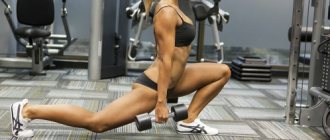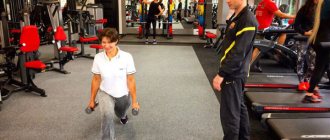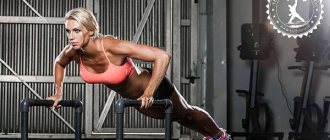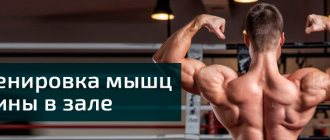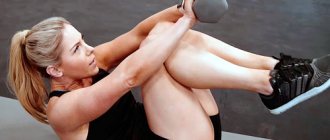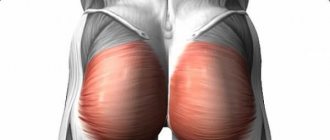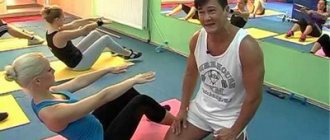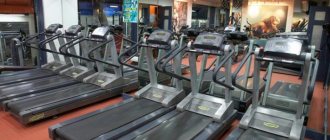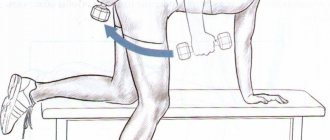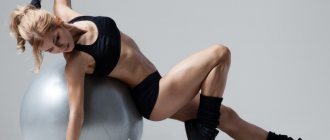Where is the trapezoid, structure and functions
Understanding the structure, functions and effective exercises for the trapezius will not only eliminate negative health consequences, but also create a powerful shoulder girdle, with highlighted trapezoidal “bumps”, which are the hallmark of many professional athletes.
The trapezius is a muscle that forms the outer layer of the upper back. It starts from the neck and reaches almost to the middle of the back. It has the shape of a trapezoid, which is where it got its name. Depending on the level where the trapezius muscle is located, its three parts are distinguished:
- Ascending (lower) part.
- Transverse (middle) part.
- Descending (upper) part.
Although each part has some differences, the functions of the trapezius muscle are common. All three areas work as a single unit. It has a complex structure, since the fibers are located in different directions. In order to pump up the trapezoid, it is worth taking this feature into account, dividing the load into each part.
The main reason why the trapezius back muscle is not given enough attention is the visual aspect. Its upper part is very pronounced, and the middle and lower parts are partially lost against the background of the more massive latissimus muscles. However, the entire array of trapezoids plays a critical role. It serves as a kind of “shield” for one of the most vulnerable and vital parts of the spine, affects posture and is involved in almost all movements of the arms and shoulder girdle.
Ascending part of trapezoid
The ascending part begins from the supraspinous ligaments of the thoracic vertebrae and the spinous processes of the T4-T12 vertebrae. Anatomically, the trapezius muscle in this area is attached to the medial part of the spine of the scapula (via the aponeurosis). The lower part is responsible for pressing the medial edge of the scapula to the chest. Also, together with other muscles, the lower part presses the shoulder blade to the body. Due to this, the shoulder girdle is stabilized.
Transverse part of trapezoid
Anatomically, the trapezium in the middle part (transverse) begins from the nuchal ligament, spinous processes and supraspinous ligaments in the region of the C5-T3 vertebrae. Attaches to:
- Akromion.
- The spine of the scapula.
- Acromial end of the clavicle.
The main task is stabilization and adduction of the scapula. It is also the thickest part of the area, so with regular trapezius exercises, it can stand out noticeably under the skin.
Descending part of trapezoid
This part is often called the trapezius muscle of the neck, as it arises from the external occipital protuberance, the cranial part of the nuchal ligament and the medial part of the superior nuchal line. Attachment of trapezius muscle:
- Akromion.
- Lateral part of the clavicle.
- Spinous processes of the cervical vertebrae (from 1 to 4).
The main function is the formation of the external relief of the neck, protection of the spine, fixation of the shoulder blade and shoulder girdle. Also, the upper trapezius muscle actively interacts with other muscles, sharing their functions. She also participates in extension and rotation of the head.
The functions should be considered taking into account the anatomy of the trapezius muscle of the back and the division of the area into three parts:
- Upper – adduction and external rotation of the scapula, elevation and protraction of the shoulder girdle.
- Medium – adduction of the scapula and retraction of the shoulder girdle.
- Lower – adduction, lowering and external rotation of the scapula, lowering the shoulder girdle.
In general, all three parts act as a “coordinator” in many movements of the shoulder girdle, which is why training the trapezius muscle is considered necessary not only in sports, but also for the health of the back and spine.
A set of exercises for the gym
Performing a set of exercises for the trapezius muscles in the gym makes it possible to organize the training process with the participation of a personal trainer or fitness instructor.
The trapezius pumping program may look like this:
- Monday - warming up the muscles, Lee Haney deadlifts, Romanian deadlifts with dumbbells, pulling the weights to the waist;
- Tuesday – increased nutrition, daytime sleep and restoration of the body;
- Wednesday – warming up muscle fibers, raising dumbbells to the sides, push-ups (15 times, 3 sets), lifting dumbbells behind your back;
- Thursday – muscle recovery, increased nutrition, daytime sleep and proper rest;
- Friday – shrugs on an incline bench with dumbbells, pull-ups on a horizontal bar (10 times, 3 sets), shrugs with weights behind your back.
- Saturday – comprehensive training of the cardiovascular system, which includes jogging on a treadmill (distance 1.5 km), squats (20 repetitions of 5 approaches);
- Sunday – drink plenty of fluids, eat more, sleep during the day and complete psycho-emotional calm, aimed at restoring the body’s physical strength.
Exercises performed on the trapezius muscle involve the use of sports equipment such as barbells, weights, dumbbells, and weights. Most training for this part of the thoracic and cervical spine involves power pulling weights with the athlete’s body in a horizontal position on a bench press bench, or slightly tilted forward.
The first positive result of pumping the trapezius muscle can be observed after 2 months of intense training.
Features of trapezius training
To pump up the trapezius muscle you do not need to perform a huge number of exercises. It is enough to include 2 to 4 movements in the training program to get stable progression in the area. However, this is the main problem. Due to its “unpopularity” (as well as a lack of understanding of the importance of the muscle), upper back exercises are most often neglected by athletes. This leads to an imbalance in the development of the back muscles, which can negatively affect not only the progression in other exercises, but also the health of the spine and posture.
In addition to visual and aesthetic problems, poor tone can lead to a number of complications, from neck pain to postural distortion with an increased risk of protrusions. Also, one of the most popular consequences of insufficient training of the trapezius is cervical hyperlordosis. Along the chain, it is compensated by the development of lumbar hyperlordosis, which generally leads to serious problems and a deterioration in the quality of life.
The first thing to remember is that exercises for the upper back should not be performed with heavy weight.
Firstly, this will increase the risk of injury, and secondly, the movement will be carried out at the expense of other muscles. As a result, all exercises for the trapezius back muscle will be ineffective for the target area. Only as the strength and volume of the muscle increases, you can increase the weights to pump the trapezius more effectively. The main problems that can arise when the muscle is overloaded (with heavy weight, training volumes or incorrect technique):
- Pinched nerves.
- Headache.
- Pain in the neck or shoulders.
- Worsening problems with intervertebral discs.
Basically, all problems occur due to excessive compression. For this reason, trapezius exercises in the gym should be done no more than 1-2 times a week (or no more than 15-18 approaches per week). Also, taking into account the specifics of working on this area, preference should be given to multi-repetition approaches , 12-20 times per set.
Warm up before training
Exercises on the trapezius muscle should not be performed without prior warm-up. It consists of the following actions:
- Jogging at a distance of 300 m.
- Turn your body to the sides. 20 repetitions on the right and left sides.
- Rotational movements of the shoulder joints. Warm up both hands at once or each one in turn. It is recommended to do 30 repetitions.
- Bends forward and backward, which consist of 35 repetitions.
- Rotational movements of the head. It is necessary to make 30 turns to the right and left.
- Tilt of the neck forward and backward. You should perform 25 repetitions.
The completion of the warm-up is to independently warm up the back of the neck and upper back using massage movements. The average duration of preparation for the training process is 15 minutes.
Top 3 best trapezius exercises for home and gym
Almost all movements can be performed with dumbbells or a barbell. Therefore, you don’t have to worry about how to pump up your trapezoid at home. The whole range of possibilities will be available even for home. Moreover, you don’t even need dumbbells for training (although doing the movements is much more convenient with them). To inflate your trapeze at home, you only need a couple of water bottles (5-8 liters) or any weight loaded into bags.
Shrugs
The first and most universal movement that must be included in the program to pump up the trapezoid at home or in the gym. Can be performed with dumbbells, barbell or any other weight. It is important to remember the following technical features:
- When performing shrugs, you need to turn your shoulders back (squeezing your shoulder blades together).
- Only the shoulder joints are involved in the exercise; visually the technique is similar to shrugging the shoulders.
- Focus on your traps so that you use them to lift the weight rather than other muscles.
It is optimal to perform shrugs in 3-4 approaches, 12-20 repetitions.
Read more about the shrug exercise →
Pull to the chin (broach)
The exercise is usually classified as a shoulder training group. Although when using a narrow grip, the main load will switch to the trapezius.
To pump up your upper back, include movement on the day of your back workout, but only in the second half of the session (when the core muscles are tired and will not take the load from the trapezius).
Read more about the stretching exercise →
Lee Haney Deadlift
In fact, this is one of the shrug variations that became famous thanks to Lee Haney. The big advantage of the exercise is that in addition to the trapezius, the rear deltoids are also actively loaded. This helps improve posture.
Important points when performing the movement:
- One of the most popular mistakes in technique is pulling using the forearms; it needs to be eliminated and controlled.
- You need to carefully select the weight so that the load falls on the trapezius.
To avoid overloading the trapezius, it is recommended to alternate Lee Haney deadlifts with shrugs.
The best exercises for the trapezius
Enough unnecessary words, it’s time to start describing the best exercises for the trapezius. Choose for yourself those that work for you and implement them in your training programs.
Shrugs with a barbell in front, behind the back and in Smith
The barbell is the most common type of weight and is very suitable for developing the trapezius. We are not interested in all the exercises with it, but specifically in one “Shrugs”. They are aimed at training the upper trapezius muscles. From the outside, the movement itself resembles a shrug. There are several varieties:
Barbell at front
This is a classic option for performing shrugs. The bar is located in front of you. We grab the bar with an overhand grip (palms facing back). In this option there will be a large amplitude of movement due to a slight forward bend. In this option, all three sections of the trapezoid will receive the load, but 80% will fall on the upper part.
The best exercises for the trapezius
Barbell behind your back
This option is slightly modernized and only works on the top of the trapezoid. The amplitude of movement will be smaller, but the target muscle will work. We hold the barbell behind our back. To make it more convenient for us to do the movement itself, we will need to tilt the body a little forward. This option is more difficult, so you should not start your first year of training with it.
Shrugs in the Smith machine
You can perform both options in the Smith machine. That is, hold the barbell both in front of you and behind your back. Working in Smith, we isolate the trapezius and remove some of the load from the back. Thus, we can concentrate only on working the trapezius muscles.
Execution technique
:
- Step up to a rack or Smith machine. Take the barbell from the front in front of you, or from the back behind your back. Hands shoulder-width apart, overhand grip.
- We remove the bar from the rack or from the locking devices of the simulator.
- Bend your torso slightly forward and bend your legs slightly. This will add more strength to your rack.
- As we inhale, we begin to pull our shoulders up, as if we want to touch the tips of our ears with them.
- Hold for a moment and feel the tension in the trapezius. Then slowly return to the starting position. And breathe out.
In front of
Behind the back
Throughout the entire exercise, your arms should be straight, both at the bottom and at the top. You also don’t need to help yourself with your legs or push out the weight. We only work with trapeze! As for the body as a whole, we keep our back straight and do not round it under any circumstances.
Shrugs with dumbbells: standing, sitting and lying
Shrugs with dumbbells are a great alternative for beginner athletes. Of course, they are also performed by professionals, many even consider them the best exercise for the trapezius. They can be done in several variations: standing, sitting and lying on a bench press. The most important difference from shrugs with a barbell is the location of the weight itself. Since the dumbbells are on the sides, we can keep the body strictly vertical. Due to this, we will be able to lower our shoulders lower. Consequently, the amplitude of movement becomes larger.
Standing dumbbell shrugs
This option is more common in the gym. Firstly, it does not require special preparation (the same bench press, installed at different angles). Secondly, a comfortable range of motion. Thirdly, the possibility of using cheating (repetition using other muscles, legs or back). But as always, I would not recommend using it, especially for beginners. There is also a minus: when performing the exercise while standing, you will also have to focus on stabilizing the body.
Shrugs with dumbbells while sitting
Also a fairly common exercise. To perform it, you will need a bench press, on which we will sit. Working out the trapezius in this version will be more isolated, since the lower part of the body is excluded from the exercise. The load on the spine will also be reduced. But there is one inconvenient moment when performing the exercise. You will have to focus not only on maximizing the contraction of the trapezius, but also on not catching your thighs with the dumbbells.
Shrugs with dumbbells lying on an incline bench
This option is the most technically complex. If the technique is incorrect, the rear deltoid will do all the work, not the trapezius. In prone shrugs, the upper and middle parts of the trapezius work, giving them relief and a peak shape. It also helps improve posture. Due to the fact that we lie on a bench, all the load is removed from the spine. At the initial stage, it is better for beginners not to perform shrugs in this version. Since it is more traumatic than the others and if the technique is incorrect, you can injure the shoulder joint.
Execution technique
:
- Hold the dumbbells in your hands with a neutral grip (palms facing inward towards your hips).
- Keep your back straight. The gaze is directed forward. When performing the seated version, lower yourself onto the bench with your feet together so as not to interfere with the movement of the dumbbells. For the incline variation, lie down on the bench. Your chest should not sag under the weight of the dumbbells. We also maintain a deflection in the lower back.
- As you exhale, raise your shoulders with dumbbells up.
- After a short pause, we begin to lower our shoulders down to the starting position and exhale.
standing
Sitting
Lying down
Keep your arms straight throughout the entire movement. If you bend them at the elbow, the biceps and forearm will take the load. Do the movement with maximum amplitude. But you shouldn’t overdo it so that other muscles, the back or deltoids, don’t get involved in the work. Also, the movement itself should be smooth and controlled. There is no need to rotate your shoulders in a circular motion while lifting. This will only injure your shoulders.
Chin row: barbells, dumbbells and block exercise machine
The chin row is an exercise for developing the deltoid muscles (middle and back), but also part of the load goes to the trapezius (upper and middle part). It is very effective and easy to do. But before you put it into your training program, there are some things you need to know. Firstly, you need to keep your back straight, especially avoid bending forward. Thus, we will be able to load the trapezius, and not the rear deltoids. Secondly, the grip should be narrower than shoulder width. We do this for the same reason, so as not to work with deltas. The exercise can be performed with different equipment: a barbell, dumbbells and on a block machine.
Barbell Chin Row
Unfortunately, this exercise will soon fall into the red book. Every day it becomes less and less common to see it performed by someone else. But this does not mean at all that it is not effective. And if you are serious about training your body and developing your trapezius, then you simply must find a place for it in your workout. The bar can be used either flat or curved. You will not notice any changes in muscle function. But the load on your wrists will be reduced. Also, the grip must be narrow in order to isolate the trapezius from the deltoids as much as possible. Training with a barbell is the most traumatic option and you can easily damage your shoulder. Therefore, choose a weight that you can handle at the moment.
Chin row with dumbbells
Dumbbells are a great alternative if you don't like doing barbell exercises. Moreover, there are some differences. When working with dumbbells, we work each muscle separately (left and right parts). This reduces the imbalance between them, which is good news for us. Also, dumbbell rows are less traumatic than the same option with a barbell. Since the weight of dumbbells will be much less.
Chin row on a block machine
A block trainer is a kind of modification of barbell deadlifts. This option is perfect for lovers of drop sets (working to failure with rapid weight loss). And if all the barbells in the gym are occupied, then you can go do deadlifts on the lower block. You can also use a straight or curved handle.
Execution technique
:
- Take the type of weight you have chosen in your hands with a narrow grip (if these are dumbbells, hold them together). Feet shoulder-width apart, back straight, body standing upright without bending forward. Hands down. There is no need to stretch the trapezoid at the starting point, so as not to exclude it from the movement. This is your starting position.
- Take a breath and, holding your breath, begin to raise your arms up, by contracting the deltas and trapezius muscles. Pull the barbell, handle or dumbbells to chin level. In this case, the elbows should be higher than shoulder level. At the top point, exhale and strain the trapezius as much as possible.
- After a short pause, lower the projectile to its original position.
Barbell row
Dumbbell row
Block pull
Although the technique is simple, you need to keep an eye on your elbows so that they are always above shoulder level and pointing upward. Also, control the position of your body; when lowering, do not tilt it forward under the weight of the projectile you have chosen. Your movements should be smooth without jerking. And don’t take too much weight, as you will start working not only with your deltoids and trapezius, but also with your back. Therefore, the trapezius will not work as a target muscle, and we don’t need that.
Rows to the face on a block machine
This exercise is aimed at working the deltas, but the middle and lower trapezius are also involved in the work. The exercise is simple, but requires certain skills. Before you begin, you should stretch your shoulders. To maximally load the trapezius in this exercise, you need to squeeze your shoulder blades as hard as possible.
Execution technique
:
- Set the desired weight on the block. Attach the rope handle and grab it. The grip is parallel (palms facing each other). Take a few steps back to tighten the cable. Feet shoulder width apart. Keep the body straight. Lean back a little.
- As you exhale, pull the handle towards your face, while moving your elbows back and slightly to the side. Retract your shoulder blades as much as possible (in the classic version we work only with deltoids)
- Stay in this position for a while. Return to the starting position by taking a deep breath, while stretching the trapezius as much as possible.
Place more emphasis on the work of the trapezius, not the deltoids. Also watch your elbows, they should always be higher than your shoulders. In this exercise, the main thing is to control the weight, feel the stretch and contraction of your muscles. Don't use too much weight because you will be pulled by the cable when you return to the starting position. Consequently, you will lose your balance and may injure your shoulders.
Overhead Shrugs
This exercise is one of the few that is aimed at working the lower trapezius. Thanks to it, you can increase your upper body strength and correct your posture. But unfortunately, this exercise has become so rare in gyms that 90% of athletes have never heard of it. It’s good that we got to know him within the framework of this article and through joint efforts we can again return him to his former glory. Such shrugs are performed both with a barbell and with dumbbells (this option will be more gentle on your shoulders). Be sure to stretch your shoulders before you begin. This will help to avoid grass, as a lot of stress will be placed on the shoulders.
Technique:
- Take a barbell or dumbbells in your hands and lift them above your head, as if you were doing a seated barbell press. Feet shoulder-width apart, knees slightly bent. There is also a sitting option. If you do this then sit on a bench press set at 90°.
- As you exhale, shrug your shoulders upward, trying to bring them as close to your ears as possible. Stay in this position for a short time, straining your trapezius as much as possible.
- Next, as you exhale, lower your shoulders, returning to the starting position.
The exercise from the side is very similar to regular shrugs, the only difference is the position of the barbell. Keep your arms slightly bent while doing this to reduce the stress on your elbow joints. Don't take on a lot of weight right away, take care of your shoulders.
I hope the article was useful to you. Share it with your friends and acquaintances on social networks and help them also gain useful knowledge. You can find out even more about exercises for the trapezius in our article “Shrugs. What you need for your trapezoid!
Good luck to everyone and great results in your training!
Functional Features
Conventionally, this muscle group is divided into three sections: upper, middle and lower. We will also not be an exception, especially since a set of trapezoid exercises should and will include training aimed at each of the departments - this is the only way we can achieve the right result.
Let's look at the functional features of each department, because choosing the best, most effective exercises is only possible when you understand the mechanics.
So, the upper trapezius: is responsible for the lifting, that is, upward movement, of the shoulder girdle and shoulder blades. They are best worked with all kinds of shrugs: with a barbell, with dumbbells - any kind. In principle, shrugs are your basic exercises when working on the trapezius.
Middle section: responsible for the movement in which you spread your shoulders, while moving your shoulder blades towards each other. The best training here is incline rows.
The last, lower section: is responsible for lowering the shoulders and shoulder blades down. The most suitable training here is an exercise that is very familiar to you when training your shoulders - the overhead press.
Well, let’s not sit around for long: warm up well, especially your shoulders, and it’s best to do a few pull-ups and push-ups. And then we’ll do the trapezoid.
Barbell
It would be logical to start from the top - that’s what we will do. Our first exercise for the upper trapezius will be barbell shrugs. It is advisable to choose a heavier weight, but such that you can do 10 repetitions per approach. Guide yourself - your muscles will tell you, but don’t rush to super-loads right away - increase the load gradually.
Feet shoulder-width apart, knees slightly bent. Hold the barbell with an overhand grip, the width also approximately equals your shoulders. Chest forward, lower back in a slight arch. Inhaling, let's begin: try to raise your shoulders as high as possible, towards your ears, fixate for a couple of seconds and, exhaling, lower them. You do everything smoothly, without jerking, and work only with your shoulders and only up - rotating them, your neck, can be traumatic. 4 sets of 10 times with breaks of no more than 2 minutes, or better yet less - the optimal regime.
Now let's tackle the middle part - we'll perform barbell rows to the chin. It is thanks to this exercise that you will achieve maximum relief, clearly outlining the trapezius muscles from the deltoids on your back. This training works well on both muscle groups, and you can control the emphasis yourself: the narrower the grip, the more concentrated it is on the trapezius, and, accordingly, the wider it is on the delta.
Feet shoulder-width apart, barbell at hip level. The main thing: make sure that your elbows always look to the sides, the movement is strictly in a vertical plane, along the line of the body, and throughout the entire training, the abs should be in good shape and tense, in order to avoid injury.
So, inhaling, tighten your trapezius and neck muscles and lift the barbell to your chin, spreading your shoulders to the sides. Having raised it all the way - your elbows should be above the line of the shoulder girdle, fixate for 2 seconds, and exhale, lower your arms.
Dumbbells
Shrugs with dumbbells are the most effective exercises for the trapezius, while at the same time actively working the entire upper body: shoulders, neck, back in general.
Choose heavier dumbbells and let's get started. Place your feet shoulder-width apart and grab dumbbells. Hold them in your freely lowered hands with your palms facing you, slightly turned inward, towards your hips. The execution is the same as with a barbell: raise your shoulders up as high as possible - the higher, the stronger the contraction of the upper trapezius and the muscles that lift the shoulder blades. 3 to 10 - work in this mode, just make sure that neither your arms nor your shoulders make any unnecessary movements, and those that are needed are done softly and smoothly, without jerking.
We will perform the second exercise with dumbbells for the lower trapezius. As we said, you can pump up this department by lifting weights above your head. As far as I know, there are very few specific isolation trainings for the lower region, and they are done in combination with other muscle groups. But, nevertheless, I have chosen the most insulating one especially for you.
Take dumbbells, sit on a bench, lean forward and raise your arms to the sides - this is the starting position. From this position, try to raise your arms as high as possible to the sides - you will really feel that the load is on the lower part.
In principle, you can perform a full fly, or row, of dumbbells, either in an inclined position or lying on an incline bench, while simultaneously working the latissimus dorsi muscles with the trapezius. However, it should be said that you can perform fairly effective trapezius exercises without resorting to the gym.
general information
It doesn't matter whether you're training for bulk or for definition, it has virtually no effect on your technique. But the amount and schedule of your workouts affect the speed at which you achieve the desired result overall.
To achieve the desired results as quickly as possible, you need to give your body time to recover. You should not train the same muscle group two days in a row. After training a muscle group to failure, you will need adequate recovery time. Working your trapezius (or your entire back) one day and returning to the same group two days later will not achieve the desired results.
The trapezius muscles will not have time to recover, and this is necessary for a full workout. If your goal is to gain mass and your muscles are in the process of recovery, subsequent back training may only lead to injury.
With all this in mind, it is best to work on this group once a week. And after a powerful trapeze workout like this, you need to get plenty of rest and recovery. In addition, the load on the trapezius will be present when training the back and shoulders, so it will not go completely unnoticed. Sufficient rest time is a guarantee for the best results.
The number of repetitions and approaches will differ when training for relief and for mass gain. When bulking, you'll be using the highest possible weights, which means you'll be able to perform one to four reps before muscle failure.
The number of approaches required when gaining weight is on average 3-5.
These exercises will explode your muscles if you do them with as much weight as possible. They allow you to gradually increase the weight for subsequent sets until you can only perform one repetition.
When working on terrain, you need to use heavy weights with a high number of repetitions. Increasing the number of repetitions is important for breaking down muscle fibers, which in turn leads to more growth.
Therefore, it is also necessary to perform 3-5 approaches, but instead of 1-4 repetitions, as when working on mass gain, you need to do 8-12. Never stop at 12 reps if you can do more. Continue the exercise until failure. Let 8-12 reps be your guideline, but don't limit yourself to them. If you're doing more than 8-12 reps, that means it's time to increase the weight. Don't save energy for the next approaches.
The only possible way to improve relief and strength is to work the muscles to failure.
Description of the muscle
The trapezius is a flat, broad muscle that is located in the upper back and forms the shoulders.
Anatomy
The location of the trapezius is in the upper back; they form a triangle, connecting the spinal muscles with the cervical and deltoids.
The trapezius muscle of the back is divided into three parts: middle, upper and lower. The most effective part is considered to be the upper one, and it is pumped up primarily with shrugs. As you know, the trapezius muscle begins near the neck, and its end is located between the shoulder blades; in this case, shrugs alone are not enough.
It is possible to pump up the middle part of the trapezius with swings and rows, but the lower part, the one located between the shoulder blades, begins to work when lifting projectiles above your head.
Meaning
If the trapezius muscle, as well as the muscles of the lower part of the shoulder girdle, have insufficient pumping, then this will affect the overall perception of a person’s figure. In this case, weak muscles will not be able to maintain correct posture and in such circumstances it will cause you to hunch over.
Contraindications
Practicing shrugs is contraindicated for people who have severe spinal diseases. It is also recommended to consult with your doctor in order to avoid injuries when performing training exercises, which can aggravate the athlete’s condition.
The caveat is to limit the progression of loads. Traps begin to progress slightly faster in weights compared to any other exercise. Thus, when strong trapezius begins to lift the shoulders too high, this will affect the athlete's spine, causing him harm.
People who want to pump up their trapezius are not recommended to exercise if they have a torn lower back. In the current situation, you will always need to be insured by using a weightlifting belt.
People who have problems in the shoulder joints are not recommended to perform barbell rows. This is because most of the load will be placed on the deltoids, applying a risky angle, which in turn will result in additional injury.
Basic recommendations for performing trapezius exercises
Before you start training, check out some recommendations:
- At the beginning of your workout, you should do a good warm-up, this way you will avoid injuries. After training, we recommend stretching, which will make your muscles more elastic.
- We have already found out that the trapezius is divided into parts, and it is advisable to work out each of these parts with different exercises, but combining them into one workout is practically impossible, since the muscle has radically different functions. Training option: in one week, focus on the top (all kinds of shrugs) and the middle of the trapezius (bent-over rows, T-rows, horizontal block rows, rowing machine), and in the other, on the top and bottom (overhead swings, upper traction).
- Combine a trapezius workout with a back or shoulder workout once a week. This is an ideal combination, since the trapezius, deltoids and lats complement each other and develop together harmoniously and symmetrically. We recommend creating your training plan based on the size of the muscle group. So, in first place in size are the lats, then the deltoids and then the trapezius. For example, if you are planning a lat workout, be sure to do a few trapezius exercises at the end of the workout. You can find out how to work the latissimus dorsi muscles in the article “How to pump up your wings.”
- The trapezius responds better to heavy weight work. An effective way is the pyramid method, that is, increasing the weight in each approach.
- In the strength version of training, perform 4-5 working approaches and the repetition range is 8-10. But depending on your goals and training program, the number of sets and repetitions may vary.
- Eat a balanced diet. We recommend consuming carbohydrates before training so that you have enough strength and energy to work with heavy weights during training, and afterward consuming protein foods for better muscle mass growth. While gaining muscle mass and strength, we recommend consuming more calories than you burn. Drink plenty of water.
